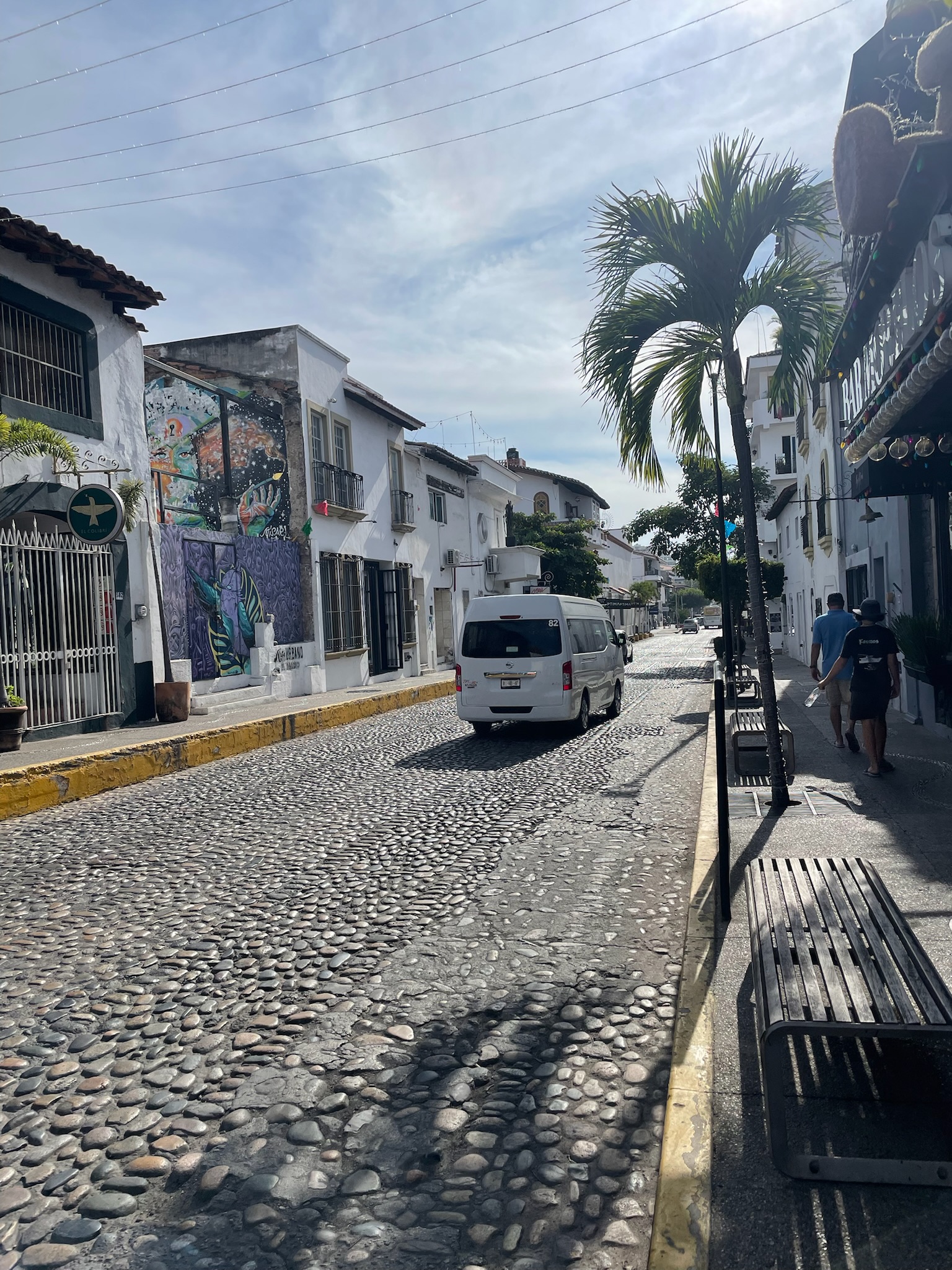Sunrise on Saturday, December 14:

We started the day off with morning chores. Eric was convinced that there was still kelp or a line caught in the propellor, but none of us were particularly eager to get in the water to look.

Eric attached an underwater video camera on a boat hook and stuck it in the water. Eric was vindicated when the footage showed that there was something tangled in the propellor!
At noon, the car rental place delivered a car to us. We immediately hit the road, heading south to Puerto Vallarta. While it was only 9 miles away as the bird flies, it was 20 miles on the road that parallels the bay. The highway was wide, well-maintained and flat, but there was a fair amount of traffic and a lot of traffic signals, so it took over an hour to get there.
We immediately knew when we’d entered the historic district because the road suddenly transformed from a wide concrete highway to a narrow cobblestone road.


We drove through the small historic district to the southern end of the malecon (boardwalk that runs along the waterfront), where we found a parking garage under the town square/amphitheater at the end of the malecon. When we exited through the town square, we saw a market was in progress.
We walked inland two blocks to get tacos at a place called Panchos Takos, which an ex-pat had said were the best al pastor tacos in town. We were disappointed to see that it hadn’t opened yet. We made our way back to the town square to get food at the market. It was 1405. The market must have ended at 1400, because the vendors were tearing down their stalls. We saw one was still open, and we got in line. We were the last people served before they closed down.

They were selling what appeared to be large tacos that were grilled… almost like a panini but with tacos. We think they were called machetes, but we weren’t sure. Upon eating them, we determined that the corn tortillas were dipped in a salsa before they were grilled, making the texture of the shells somewhere between a soft taco and a hard taco.
Once we were done eating, we strolled up the malecon for a mile. It reminded us a lot of the malecon in La Paz. The views of the crescent-shaped bay were scenic, and the walkway was dotted with vendor stalls and statues all along the way.




They were in the middle of setting up Christmas decorations.

We followed the malecon to MuseoChoco, a chocolate store that offered chocolate making classes. The downstairs had a “production area” and a tiny shop. In addition to the usual things you’d expect to find, (ie assorted flavors of chocolate bars, chocolate sauces for desserts, cocoa liquor, cocoa butter, etc), it had all sorts of chocolate items that we didn’t know existed, such as chocolate teas, soaps, shampoos, lip balms, etc.
Upstairs was a small, free museum on the history of chocolate, as well as the area where the chocolate making classes were held. The museum was mostly a collection of informative signs (which were in Spanish, English and French), with a few displays showing what the chocolate looks like at each stage of production.
The cacao tree is a tropical plant that originated in the northwest Amazon basin. Since the fruit is delicious, it was cultivated in other regions, including southern Mexico. Mexico is believed to be the first place where the seeds were refined into chocolate, around 1800 BC. There are currently 40,000 farmers in Mexico that grow cacao!
The cacao flower is tiny, and it is surprising how big the cacao fruit (AKA pod) is given the small size of the flower. Chocolate is made from the fruit’s seeds, and each pod has about 40 seeds each. The shells of the seeds are removed and the insides of the seeds are fermented for about six days. After fermenting, the seeds are dried and then roasted. After roasting, they are placed in a winnower, which separates the innermost part of the seed – the nibs – from the outer part. The nibs are grinded into a bitter semi-liquid paste called cocoa liquor. The liquor can be placed in a melanguer machine to mix it with sugar and other ingredients to make chocolate, or the liquor can be pressed to separate it into cocoa butter and cocoa powder.

Spiced cocoa liquor was a drink of the elites in the Mayan culture, and is still drank this way in Mexico. Cacao was even used as a currency in the Mayan and Aztec cultures. In the 17th century, the European elite started to consume cocoa liquor, though they added sugar and milk to make it less bitter. The Europeans eventually refined chocolate into a solid form and invented machines to make mass production possible. European empires implemented cacao plantations in their tropical colonies and chocolate became big business.
To be continued…

We love PV. Great spot to be for a while. The colonial town has so many amazing restaurants.